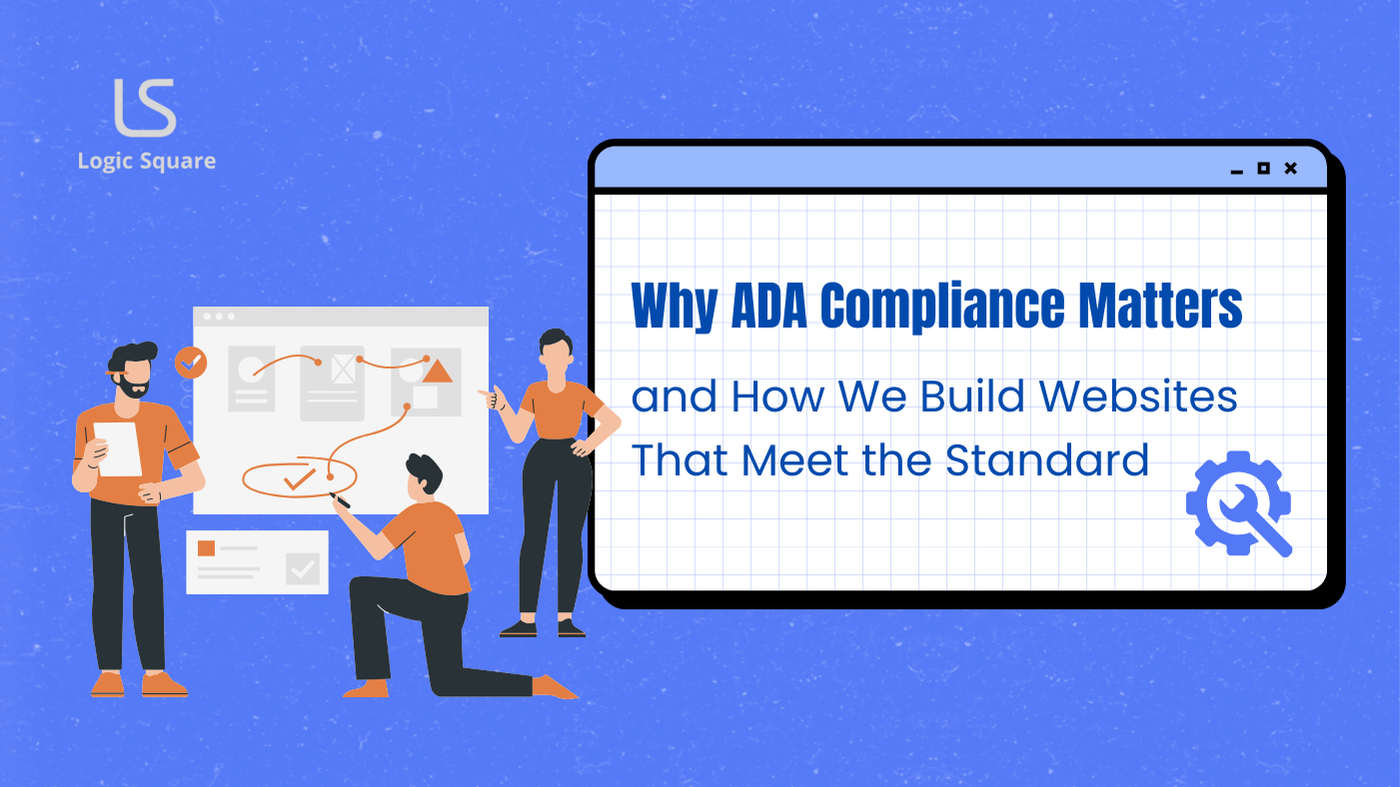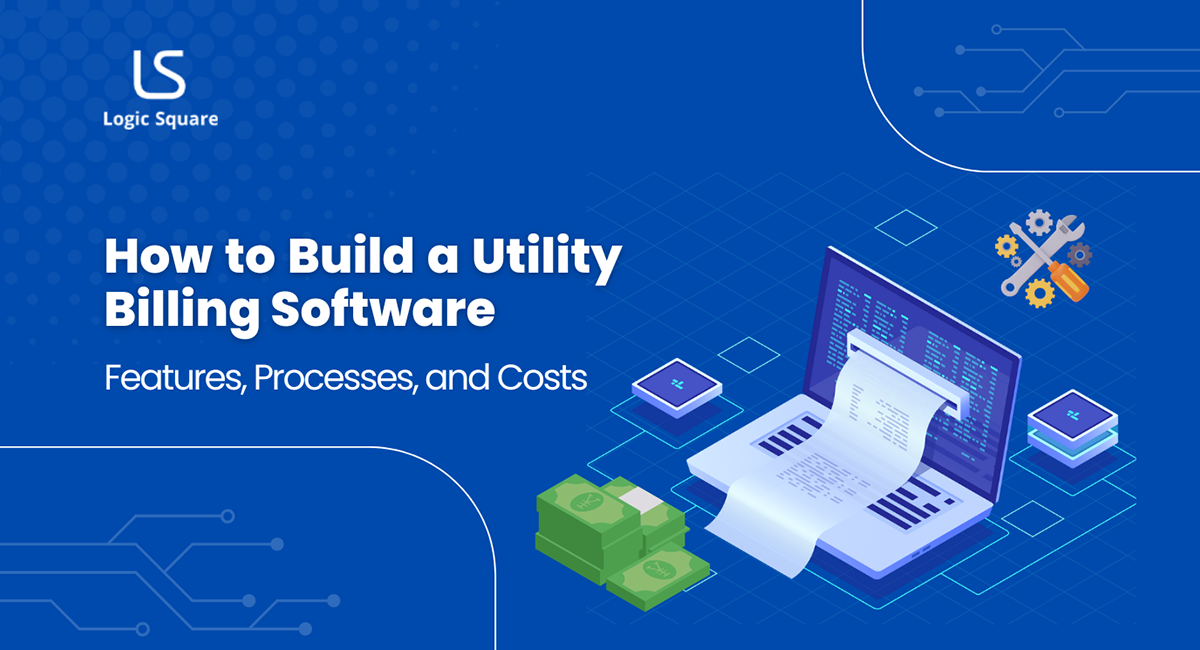In today’s digitally driven world, a business’s website is often its first point of contact with customers. But what happens when that digital doorway isn’t open to everyone? That’s where digital accessibility comes in. Digital accessibility ensures that websites, apps, and online platforms are usable by everyone, including people with disabilities.
Whether it’s someone with low vision trying to navigate a page with a screen reader, or a user with motor impairments relying on keyboard navigation, accessibility is about creating an equitable user experience. And for businesses, it’s not just a matter of ethics; it’s a legal obligation, a business opportunity, and a powerful tool for enhancing brand value.
Table of Contents
ToggleIn this blog, we’ll break down why ADA compliance is so essential, explore the standards that define accessibility, highlight the best practices we follow at LogicSquare Technologies, and show how it all adds up to a stronger, more inclusive web presence.
Why ADA Compliance Matters
a. Legal Imperatives & Risk Mitigation
Title III of the Americans with Disabilities Act (ADA) prohibits discrimination against individuals with disabilities in places of public accommodation, and yes, this now includes websites and digital services. In recent years, there has been a significant spike in lawsuits targeting companies with inaccessible websites.
Non-compliance isn’t just risky, it’s expensive. Legal fees, fines, and the reputational damage from a public lawsuit can be substantial. Even if you’re not currently facing legal action, failing to meet accessibility standards leaves your business vulnerable.
b. Tapping an Underserved Market
There are over 1 billion people worldwide living with some form of disability. That’s a massive audience your business could be missing out on if your site isn’t accessible.
An inclusive website doesn’t just meet legal requirements; it opens doors to more customers, more engagement, and greater loyalty. If you’re building a platform to grow your business, why not make it accessible to everyone?
c. Enhanced UX & SEO Gains
Many accessibility improvements, such as clearer navigation, keyboard operability, and well-structured content, benefit all users, not just those with disabilities. For instance, adding alt text to images helps screen readers and improves your image SEO.
Accessible websites tend to be better optimized for search engines, offering faster loading times, cleaner code, and more semantic HTML. In essence, ADA compliance enhances the overall user experience while giving your site a performance boost.
d. Brand Reputation & Social Responsibility
In today’s socially conscious world, customers are paying close attention to the values behind the brands they support. An accessible website signals that your business cares about inclusion, diversity, and doing the right thing.
This not only builds trust and loyalty but also sets you apart in a competitive market. When a brand demonstrates empathy and responsibility, people notice, and they remember.
Understanding WCAG & ADA Standards
a. WCAG Foundations
At the heart of digital accessibility is the Web Content Accessibility Guidelines (WCAG), developed by the W3C. These guidelines are built around four core principles:
- Perceivable – Users must be able to perceive the information being presented.
- Operable – Navigation and interface components must be usable.
- Understandable – Information and operation must be clear.
- Robust – Content must be compatible with various devices and assistive technologies.
WCAG defines three levels of conformance: Level A (basic), Level AA (recommended), and Level AAA (highest). Most organizations aim for Level AA as a standard benchmark for compliance.
b. Legal Requirements
While the ADA doesn’t spell out specific digital accessibility standards, courts and government agencies have widely accepted WCAG Level AA as the baseline. Moreover, international regulations like the European Accessibility Act are reinforcing the importance of accessible digital design.
For businesses that operate globally, staying compliant isn’t optional—it’s essential.
c. Regulatory Trends
Regulatory bodies like the U.S. Department of Justice (DOJ) have clarified that websites fall under ADA jurisdiction. Recent legal updates emphasize that inaccessible websites can be considered discriminatory. As a result, enforcement is becoming more active and fines more severe.
For companies building digital products or websites, this is no longer a grey area; it’s a clear mandate.
Core Accessibility Features & Best Practices
At LogicSquare Technologies, we build websites and applications that integrate accessibility into the core of the design and development process. Here are some of the best practices we follow:
- Alt text for all images and graphics to ensure screen readers can interpret visuals.
- Adequate color contrast between text and backgrounds, with visual indicators that go beyond just color.
- Structured HTML using semantic elements and clear heading hierarchies (H1, H2, etc.).
- Keyboard navigability so that users who can’t use a mouse can still access all functions.
- Focus indicators that show users where they are on a page while navigating via keyboard.
- Captions and transcripts for all video or audio content.
- Simple language and clear navigation for users with cognitive impairments.
- Compatibility with assistive technologies like screen readers and the use of ARIA (Accessible Rich Internet Applications) attributes where necessary.
Building a Compliant Website: Step-by-Step
Making your website accessible doesn’t have to feel overwhelming. In fact, when you break it down into manageable steps, the process becomes not only doable but deeply rewarding. At LogicSquare Technologies, we believe accessibility should be woven into the fabric of every digital experience, not treated as an afterthought. Here’s how we guide businesses through the process of building websites that are inclusive, compliant, and built to last.
a. Perform an Accessibility Audit
We start with a comprehensive audit using a combination of automated tools and manual testing with real assistive technologies. This helps uncover hidden accessibility issues that might not show up in automated scans.
b. Prioritize Quick Wins
Some accessibility fixes are fast and impactful: adding missing alt text, correcting color contrast, and fixing form labels can immediately improve the user experience and compliance level.
c. Implement & Integrate
We update the site’s codebase, design systems, and content processes to ensure accessibility is not a one-off fix but an integrated approach. Accessibility becomes part of your digital DNA.
d. User Testing
We believe nothing replaces real user feedback. That’s why we include people with disabilities in our testing process. They provide insights that even the best developers might miss.
e. Educate Your Team
For lasting change, everyone involved, from designers to content creators, must understand accessibility. We offer training and resources to help internal teams maintain compliance.
f. Ensure Ongoing Compliance
The web is always evolving, and so are accessibility standards. We conduct regular audits, track legal updates, and help you stay ahead of the curve with a proactive approach.
Benefits vs. Costs: ROI Analysis
We get it—accessibility may seem like an added expense. But here’s the truth: the returns far outweigh the costs.
- Avoid legal fees and reduce the risk of costly litigation.
- Expand your reach to include millions of users with disabilities.
- Increase conversions and improve customer retention with a better UX.
- Improve your website’s SEO and organic traffic.
- Qualify for tax credits or funding (like the U.S. Disabled Access Credit).
- Build a brand that’s known for doing the right thing.
Investing in accessibility isn’t just the right thing to do; it’s also smart business.
How LogicSquare Technologies Makes It Happen
At LogicSquare Technologies, we don’t just build websites; we build inclusive digital experiences. As a software development company, we understand that accessibility is more than a checklist. It’s about empathy, usability, and future-proofing your digital presence.
From the first wireframe to the final launch, our team integrates accessibility into every stage of design and development. Whether we’re working on a website or a mobile app development project, our goal is always to create something that everyone can use, regardless of their abilities.
We work with businesses across industries to ensure that their digital platforms are compliant, functional, and optimized for performance. And we’re constantly evolving—staying updated on global accessibility trends so you don’t have to.
Ready to make your website ADA-compliant? Let’s make the internet a better place, together.
Parting Thoughts,
ADA compliance isn’t optional. It’s essential for your users, your business, and your brand. It helps you avoid legal trouble, reach a broader audience, and build digital products that are better for everyone.
At LogicSquare Technologies, we believe in building a web that works for all. If your website hasn’t been audited for accessibility, now is the time. Don’t wait for a lawsuit or lost customers to make the change.
Let us help you take the first step. Contact us today to schedule an accessibility audit or to start building a compliant, inclusive, and high-performing website.
Because when we design with everyone in mind, everyone wins.
Ready to make your website accessible?
Get in touch with LogicSquare Technologies, your trusted partner in building ADA-compliant digital solutions.





